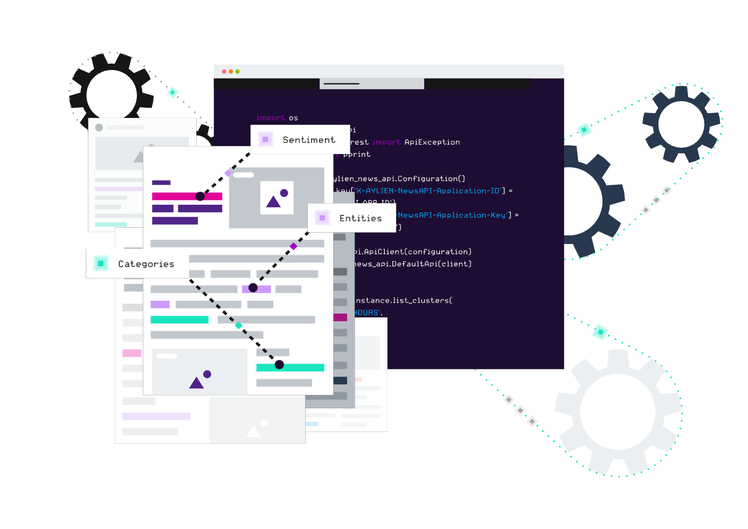Every day, your customers are telling you exactly what they need—through support tickets, survey responses, social media comments, and reviews. But with so much unstructured text data coming in, how do you extract actionable insights that actually drive better customer experience?
This is where text analysis software comes in. By leveraging natural language processing (NLP) and machine learning, the right text analytics tool can turn overwhelming volumes of customer feedback into clear, data-driven direction.
Want to know the top recurring themes in support tickets? Identify pain points before they escalate? Predict churn risk based on sentiment? The right tool makes it possible—without requiring a team of data scientists.
In this guide, we’ll break down:
What text analysis software does and how it works
The different types of text mining software
The 11 best text analysis software in 2025 and their key features
How to choose the right text analysis software for your business
By the end of this article, you’ll have a clear understanding of which tool can help you unlock valuable insights from customer interactions—so you can take action, not just collect data. Let’s dive in.
What is text analysis software?
At its core, text analysis software is designed to help businesses make sense of large volumes of unstructured text data—from customer feedback to social media comments, and survey responses. Instead of manually sifting through endless text, these tools use natural language processing (NLP), machine learning models, and text mining techniques to surface actionable insights at scale.
For a Head of CX or Head of Support, this means you can quickly:
Identify recurring themes in customer interactions
Track sentiment trends across support tickets and online reviews
Understand what’s driving customer satisfaction (or frustration)
Extract valuable insights from real-time social media monitoring
Pinpoint issues before they escalate into churn risks
How does text analysis work?
Most text analysis tools follow a similar process:
Data Collection: Aggregates text from multiple data sources, including support tickets, online reviews, chat logs, and survey responses.
Preprocessing: Cleans and structures the unstructured text by removing stopwords, normalizing text, and preparing it for analysis.
Text Mining & NLP: Applies machine learning algorithms to recognize patterns, entity extraction, and topic modeling.
Sentiment Analysis & Thematic Analysis: Detects tone (positive, negative, neutral) and categorizes themes for deeper insights.
Visualization & Reporting: Displays results via customizable dashboards, word clouds, and trend identification tools to make insights easier to act on.

The best part? Many modern text analytics tools integrate seamlessly with your existing systems, making it easy to incorporate these insights into your customer experience strategy.
Types of Text Analysis Tools
Before diving into the list of top tools, let's briefly explore the types of text analysis tools commonly used in the industry:
Natural Language Processing (NLP) Tools: These tools use NLP techniques to understand and interpret human language. They can perform tasks like sentiment analysis, entity recognition, and text classification.
Sentiment Analysis Tools: Specifically designed for analyzing sentiment in text data, these tools focus on classifying text as positive, negative, mixed or neutral, helping you gauge customer opinions and emotions.
Text Mining Software: Text mining tools focus on extracting valuable information and insights from large volumes of unstructured text data. They identify patterns, trends, and correlations within textual content.
Machine Learning Text Analysis Tools: Leveraging machine learning algorithms, these tools can automatically learn and improve their text analysis capabilities over time. They are effective for complex analysis tasks and data-driven decision-making.
11 Best Text Mining and Text Analytics Software
Here is an overview of the best text analysis tools on the market, highlighting their key features, use cases, and benefits:

1) Kapiche – AI-Powered Customer Feedback Analytics
Kapiche specializes in customer feedback analysis, offering machine learning algorithms to uncover meaningful insights without requiring technical expertise. It automatically detects recurring themes, sentiment trends, and emerging issues, helping teams refine CX strategies in real-time.
Best for: CX leaders who want an intuitive interface with powerful analytics capabilities to make sense of unstructured data from surveys, reviews, and support tickets.
Key Features:
Advanced sentiment analysis
Theme extraction and topic modeling
Customer feedback categorization
Interactive dashboards and visualizations

2) Brandwatch – Social Listening and Brand Monitoring
Brandwatch focuses on social media monitoring, enabling businesses to analyze social media comments, news articles, and online conversations. Its NLP-driven insights help brands track sentiment and customer perception.
Best for: Companies looking to monitor brand sentiment and customer discussions across digital platforms.
Key Features:
Social media sentiment analysis
Trend detection and tracking
Influencer identification
Competitive benchmarking

3) MonkeyLearn – Machine Learning-Powered Text Analysis
MonkeyLearn offers customizable dashboards and easy-to-use text analytics tools powered by machine learning models. It’s ideal for categorizing customer feedback and performing entity recognition.
Best for: Businesses needing low-code or no-code machine learning for text classification and sentiment analysis.
Key Features:
Customizable text classifiers
Sentiment analysis API
Named entity recognition
Workflow automation
4) Lexalytics – Industry-Specific Sentiment and NLP Solutions
Lexalytics provides tailored text analytics software solutions for industries like healthcare, finance, and retail. It offers topic modeling, theme extraction, and quantitative content analysis with a focus on compliance and industry regulations.
Best for: Companies needing custom NLP models and regulatory-compliant text analysis.
Key Features:
Industry-specific text analytics
Multi-language sentiment analysis
Intent detection
Data visualization tools

5) RapidMiner – Comprehensive Data Science and Text Mining
RapidMiner is a data analysis powerhouse that supports text mining, predictive analytics capabilities, and even deep learning for large-scale text processing.
Best for: Data scientists and technical teams needing an advanced, highly customizable solution.
Key Features:
Text preprocessing and cleansing
Text classification and clustering
Predictive modeling
Automated machine learning (AutoML)

6) Keatext – Customer Feedback and Sentiment Analytics
Keatext is designed for CX teams, helping them extract valuable insights from customer feedback. It uses natural language processing (NLP) to identify trends, pain points, and opportunities.
Best for: Businesses focusing on customer experience improvements through customer data analysis.
Key Features:
Feedback categorization
Sentiment trend analysis
Root cause identification
Automated reporting

7) TextIQ (by Qualtrics) – AI-Driven Text and Sentiment Analysis
TextIQ specializes in text mining and sentiment analysis for enterprise applications, integrating seamlessly with the Qualtrics suite for deeper customer insights.
Best for: Large organizations that already use Qualtrics for customer experience management.
Key Features:
Social media listening
Customer feedback analysis
Text sentiment scoring
CX management dashboards

8) Luminoso – Real-Time NLP-Powered Insights
Luminoso uses unsupervised machine learning to uncover hidden patterns in textual data, even when terminology evolves over time.
Best for: Companies looking for real-time insights into customer sentiment and emerging trends.
Key Features:
Real-time text analysis
Topic modeling
Concept clustering
Multilingual support

9) AYLIEN – NLP APIs for Developers and Businesses
AYLIEN provides powerful NLP APIs for developers, enabling businesses to extract actionable insights from textual content at scale.
Best for: Companies needing custom NLP integrations in their products or workflows.
Key Features:
Sentiment analysis API
Text classification models
Named entity recognition
Topic detection

10) WordStat – Research-Focused Text Analysis
WordStat is a quantitative analysis tool designed for researchers and analysts. It excels in word frequencies, thematic analysis, and trend identification.
Best for: Academic researchers and organizations conducting quantitative content analysis.
Key Features:
Content categorization
Statistical text analysis
Concept mapping
Quantitative content analysis

11) IBM Watson NLP – Enterprise-Grade AI-Driven Text Analysis
IBM Watson NLP brings deep learning and machine learning algorithms to text analysis, offering entity extraction, sentiment analysis, and theme detection.
Best for: Large enterprises requiring scalable AI-powered text mining tools.
Key Features:
Deep learning and machine learning algorithms
Entity extraction & sentiment analysis
Integrates seamlessly with existing systems

Choosing the Right Text Analytics Tool for Your Business Needs
Selecting the most suitable text analytics software for your business requires careful consideration of several factors. For example, your data sources, goals, budget, and technical expertise.
Here's a helpful set of criteria to keep in mind, to make an informed decision when choosing your tool:
1. Define Your Goals and Use Cases
Before evaluating any tools, clearly define your objectives and use cases. Here are a couple questions that can help drive clarity:
What specific insights are you seeking from text data? (e.g., sentiment analysis, trend detection, topic modeling)
Which data sources will you analyze? (e.g., customer feedback, social media, surveys, support tickets)
How will text analytics support your business goals? (e.g., improving customer experience, enhancing product features, competitive analysis)
2. Assess Data Compatibility and Integration
Ensure that the text analysis tool can process and analyze data from your chosen sources effectively. It's helpful when all your data is fed up to a dashboard view where you can interpret results, like a customer experience dashboard. Consider:
Compatibility with various data formats (e.g., text files, CSV, JSON, social media APIs)
Integration capabilities with your existing systems (e.g., CRM, survey platforms, data warehouses)
Scalability to handle large volumes of unstructured text data over time
3. Evaluate Analytical Capabilities
Evaluate the tool's analytical features and functionalities based on your analysis requirements:
Sentiment analysis accuracy and sentiment scoring methods
Text classification and clustering capabilities
Entity recognition and extraction for key entities (e.g., product names, customer feedback themes)
Topic modeling to uncover themes and patterns in text data
Natural language processing (NLP) capabilities for multilingual analysis
4. Consider Ease of Use and User Experience
Choose a text analytics tool that aligns with your team's technical expertise and usability preferences:
User-friendly interface and intuitive workflows for data processing and analysis
Training and support resources provided by the tool vendor (e.g., documentation, tutorials, customer support)
Customization options to tailor analysis models and dashboards to your specific needs
5. Review Security and Compliance Features
Ensure that the text analytics tool meets data security standards, and regulatory compliance requirements relevant to your industry:
Data encryption and secure storage mechanisms
Access control and user permissions to protect sensitive data
Compliance with regulations such as SOC2 Type 2, CSA, GDPR, HIPAA, CCPA, etc., depending on your geographic location and data handling practices
6. Evaluate Cost and ROI
Consider the total cost of ownership (TCO) for the text analytics tool, including licensing fees, implementation costs, and ongoing maintenance:
Compare pricing plans and subscription models based on your budget and expected usage
Assess the potential return on investment (ROI) in terms of improved insights, operational efficiencies, and business outcomes resulting from text analytics implementation
7. Seek User Feedback and Reviews
Research user reviews, case studies, and testimonials to understand real-world experiences and outcomes with the text analytics tool:
Look for user satisfaction ratings, implementation success stories, and customer support feedback
Engage with vendor demos, trials, or proof-of-concept projects to test the tool's capabilities in a real or simulated environment
In summary
In this guide, we've explored the transformative power of text analysis tools for your goals.
From extracting valuable insights, to improving customer experiences, text analysis plays a crucial role in driving business success.
As you get started on your journey with text analysis, consider Kapiche as a trusted partner for your data. Kapiche offers an intuitive and powerful text analytics platform that goes beyond data analysis, delivering actionable insights that drive meaningful outcomes.
Why Kapiche:
Advanced Text Analytics for VoC: Utilize state-of-the-art natural language processing (NLP) algorithms designed specifically for in-depth VoC text analysis.
Actionable Insights: Transform unstructured data into actionable insights with sentiment analysis, theme extraction, and trend identification.
Business-Centric Approach: Align text analytics outcomes with your business objectives, driving growth, and innovation.
Ease of Use: Intuitive interface, customizable dashboards, and powerful reporting tools make text analytics accessible to everyone in your organization.
To learn more, check out a free demo of Kapiche and see how text analysis can unlock insights for your team, fast.






